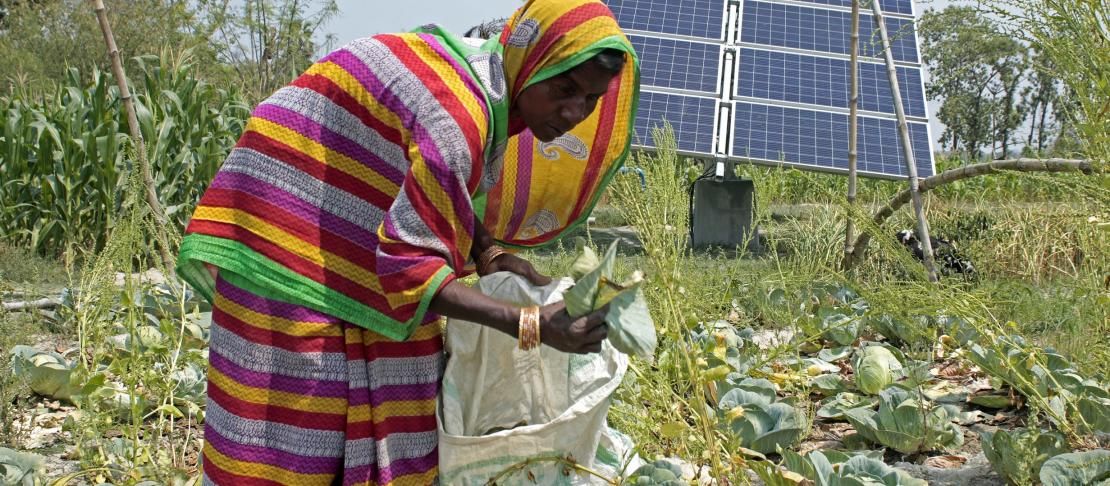Policies of hope: Promoting climate resilient technologies

A new era of sustainable growth could begin in India as the government commits finances towards the promotion of climate-smart agriculture.
Lush green farms of paddy or wheat, although a much-desired scenery for an agrarian economy like India, are one of the prime causes of increased vulnerability in the agricultural sector. This irony arises from their greenhouse gas (GHG) emissions, which in turn increases the likelihood of warming temperature, changing rainfall patterns and extreme weather events. These changes in turn directly impact agricultural systems.
This two-way relationship, where agricultural activities contribute to climate change and climate change in turn adversely impacts agricultural production and farmers’ income, has also been recognized by the Paris Agreement. In the agreement, as part of a mitigation strategy, agricultural emissions are proposed to be curtailed, while agricultural adaptation mechanisms are promoted to enhance adaptive capacities and ensure sustained food production. To fulfil this twin role, climate-smart agriculture (CSA) has emerged as an inevitability for India where more than 20% of the population lives below the poverty line.
Ray of hope
India, being a developing country, has not made any commitments to the Conference of the Parties (COP) on reducing its agricultural GHG emissions. Yet, its agricultural policies over the last few years have been striving to enhance the resilience of agriculture to climate change.
Read the journal article: Unfolding government policies towards the development of climate smart agriculture in India
A recent analysis of nine agricultural policies in India, conducted by the International Food Policy Research Institute (IFPRI) as a part of the CGIAR Research Program on Climate Change, Agriculture and Food Security (CCAFS), points out that the Government of India (GoI) has been inadvertently spending 15% of the total agricultural expenditure on climate-smart agriculture. The government of India unintentionally committed an investment of 12.12 billion USD between 2012 and 2017 towards the promotion of CSA, as part of their agricultural programs. This budgetary allocation might set precedent to promoting CSA centered policies in the future as well as supporting the GoI to fulfill its commitment made at COP21.
An in-depth review of programs, such as Pradhan Mantri Krishi Sinchayee Yojana (Prime Minister Agriculture Irrigation Plan, PMKSY), National Food Security Mission (NFSM), National Mission for Sustainable Agriculture (NMSA), National Horticulture Mission (NHM) and Rasthrya Krishi Vikas Yojana (RKVY), highlights that significant support is being offered to the promotion of climate-smart technology adoption. A total of nine such centrally sponsored agricultural programs of the Government of India were evaluated.
These nine programs together save almost 2% irrigation water, 3% fossil fuel, 6% fertilizer as compared to the usage while employing traditional agricultural practices and they also increase farmers’ income by 8.4%. Cumulative effect of these polices results in 3% reduction in GHG emissions. Present data has been brought to surface by a review of these nine centrally sponsored schemes of GoI, in accordance with the six pillars of CSA namely; water-smart, energy-smart, nitrogen-smart, crop-smart, knowledge-smart and weather-smart. The review also shows policy implications for both adaptation to climate change and mitigation of GHG emissions by means of savings done in water use, energy use, fertilizer use, farmers’ income and GHG emissions from the agriculture sector.
Upholding support and investment
Substantial financial support as part of the centrally sponsored schemes strives to work at the junction of all three aspects of CSA; increasing farm productivity and farmers’ income; adapting agriculture to changing weather patterns; and capitalizing on mitigation options available in the agricultural sector. It is being speculated that this investment will further attract investments from other stakeholders, though, the question of efficient use of these allocated resources always worries the practitioners.
In addition, policy visioning, rationalizing and converging these centrally sponsored programs with the state programs becomes vital for a diverse country like India, where nearly half the population depends on climate-sensitive occupations, like agriculture, as the source of livelihood. Furthermore, expanding or at least sustaining existing financial commitments to promote CSA should become an imperative action plan for the Government of India.
Read more:
- Journal article: Unfolding government policies towards the development of climate smart agriculture in India
Sakshi Saini is the Communication Specialist for CCAFS South Asia. Pramod Aggarwal is the Regional Program Leader for CCAFS South Asia.



